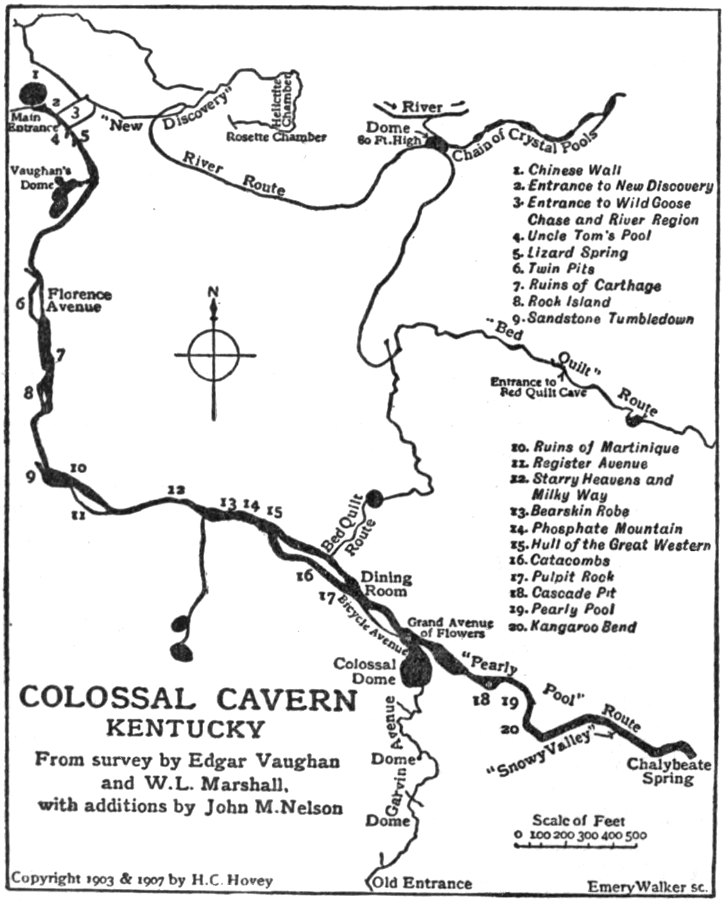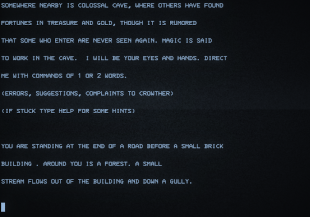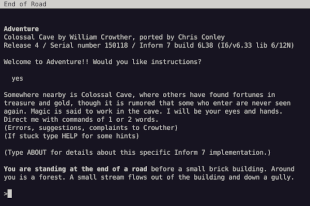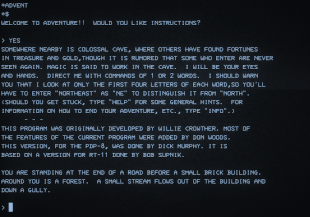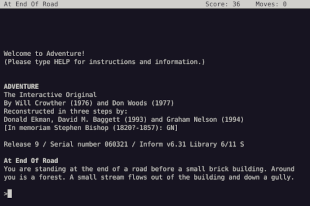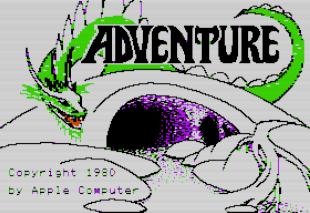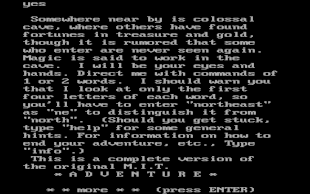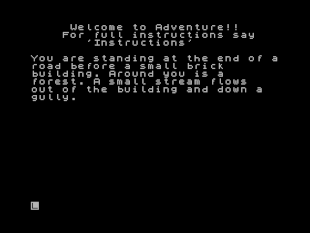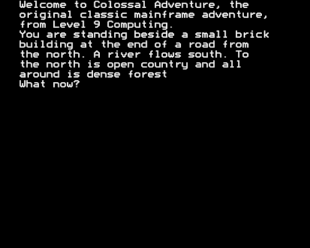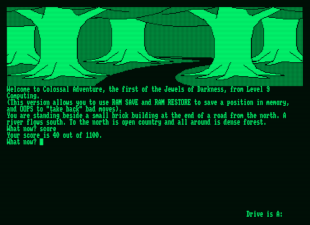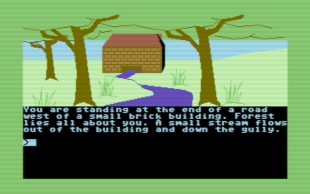
|
|||||||||||||||||
|
Retrogaming |
Mapping the Colossal Cave AdventureCave is the daddy of them all. The entire genre of text adventures, or interactive fiction as it is called nowadays, rests on this game. On this page, a number of variants of this game are enumerated and discussed briefly. The object is to compare their geographical lay-outs; it's a work in progress, and it's done for my own amusement. Contents
A brief background A brief backgroundThe history of the Colossal Cave Adventure computer game has been related in great detail elsewhere (here, here and here, for example), but here follows an abridged outline. The Colossal Cave adventure is a digital version of the Bedquilt Cave, part of the Mammoth Cave system in Kentucky USA (not the Colossal Cave near Tucson, Arizona, despite the name). Will Crowther, a computer programmer and caving enthousiast, played a significant role in mapping these caves and subsequently wrote a game in FORTRAN on a DEC PDP-10 mimicking the lay-out of the caves as an amusement for his daughters. The game was called Adventure. In it, the player could travel between locations (now referred to as "rooms") and manipulate objects in order to solve puzzles by entering one or two-word commands through the computer keyboard. This form of gaming where the player's input resembles natural language became known as a "text adventure", and later "interactive fiction".
The game was subsequently encountered by and expanded upon (with permission from Crowther) by Don Woods, a student at Stanford University, who added rooms as well as functionality. This was also the first version of the game to be called the Colossal Cave Adventure. From then on, the game found fame and success. Initially with the relative few who had access to machines like the PDP-10 that were connected to the ARPANET, but eventually the Colossal Cave Adventure was ported to smaller machines such as mini computers and home computers. At the same time it evolved into many different versions with rooms and elements added by other programmers. Different versions were often referred to by the number of points a player could earn by finding treasure. Crowther's original game did not feature a points system, Woods' version awarded a maximum of 350 points, and later games were expanded to 430 points, or 550 points, or 551 points, et cetera. It has been said that once Woods' version became known and available, regular work on many ARPANET computers stopped for two weeks as users tried to solve it (to counter this phenomenon a blocking routine was introduced so that the game could only be played outside office hours). The prose of the game itself has become part of hacker lore. "A huge green snake bars the way", "xyzzy", "twisty passages", and the notion of dwarfs coming out of nowhere and attacking you by throwing axes are phrases that can be encountered in discussions not otherwise related to Colossal Cave. With the advent of games consoles and home computers, game publishers undertook to port existing video games to these machines. Space Invaders, Pacman, and other successful arcade games were obvious candidates, but the Colossal Cave adventure was also picked up by several developers. The text adventure form was used and continued by a number of developers in the 1970s and 1980s to make new games with different themes — Infocom, Magnetic Scrolls, Adventure International, and Level 9 are some of the best known ones. After the commercial demise of the text adventure in the second half of the 1980s new games were and are still being produced by enthusiasts who due to the nature of the text game have no need of teams of coders, the latest hardware, and marketing campaigns. Some versions and portsAs mentioned above, the long history of the Colossal Cave Adventure has resulted in many different versions. The original game was written in FORTRAN, then ported to C, or to assembly language for smaller machines, and finally to dedicated languages for interactive fiction such as TADS and Inform. The object of this page is to highlight a number of variants, and to compare their respective geographies in the form of one map per version. This is a work in progress and may take a while to develop. In the meantime, I will update this page (un)regularly. The games are listed below and appear in order of the year of their original appearance (but later reconstructive ports will be listed immediately following the original). One final note: Colossal Cave Adventure is and has been referred to by different names (Colossal Cave, Adventure, ADV, ADVENT), and these are used here interchangeably. At willy-nilly, one might say. Crowther's ADV on PDP-10 (1976)
This early game has a smaller vocabulary and keeps no score. Commands should be entered in capital letters. "HELP" is understood, but "INFO" is not, and to quit the game, use <CTRL>-C. Crowther's ADV Inform 7 port (2015) This version can be downloaded from the Z-code directory of the IF Archive. Look for a file named "Advent_Crowther.z8." Woods' ADVENT on PDP-8 (1977)
The image at the top of this page shows a PiDP-8, a recreation of the front panel of the original machine that works in combination with SIMH, running ADVENT. The moving "blinkenlights" on the front panel lend an almost arcade-like urgency to the experience. Woods' ADVENT Inform port (2006) This version can be downloaded from the Z-code directory of the IF Archive. Look for a file named "Advent.z5." Apple Adventure on Apple II (1980) The packaging of Apple Adventure is a simple affair, consisting of a generic Apple-themed cardboard front with one 5.25" floppy disk and a manual tucked in the back. Microsoft Adventure on IBM PC (1981) As can be seen in the screenshot a 40-character line screen mode was used, which doesn't seem to help to make the text more readable. Oddly, it is mentioned in the introduction screen that "This is a complete version of the M.I.T. * Adventure *", but Woods was at Stanford when he first started working on his expanded version of the game and later moved to Xerox. It may be that the producer confused Colossal Cave Adventure with Zork, another well-known early game in the ganre which was first developed at M.I.T. Classic Adventure by Abersoft/Melbourne House (1982)
Colossal Adventure by Level 9 (1983/1986)
The Very Big Cave Adventure by CRL (1986) The cover art is made in a somewhat primitive "comic" style. On the reverse of the inlay is an amusing rendition of the game's genesis ("Those sniffy individuals who think that adventures are superior to mindless alien-zapping obviously never played this one"). This title came out on cassette in a clamshell box for Commodore 64, Sinclair ZX Spectrum, and various Amstrad machines. Open Adventure by Eric S. Raymond (2015)
There are no modern features added to the game's engine. There is no status line to indicate the player's location and his score, and the parser still works with commands consisting of one or two words. Links
(Originally published 2023/01/06)
|
